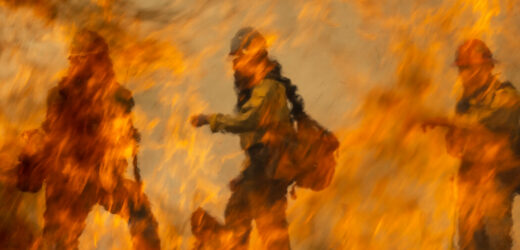The military’s satellites excel at spotting new blazes, but for decades they have been mostly off limits to civilian firefighters.
By William J. Broad
In July, as wildfires tore through the American West, President Biden met with the region’s governors to find better ways to battle the flames. Gov. Gavin Newsom of California requested use of military satellites that are designed to warn of missile attacks, calling the orbital fleet “a game changer” for spotting and fighting wildfires.
Mr. Biden promised to help. “When this meeting is over,” he said, “I’ll be on the phone with the Department of Defense.”
His call wasn’t the first — or the 50th.
The issue of using secret military gear to aid civilian firefighters arose 35 years ago. It grew as the White House, the Central Intelligence Authority, the U.S. Forest Service and other federal agencies sought to establish a national system that warned of undetected wildfires and menacing flare-ups.
The Pentagon allowed tests and a short-lived prototype. But the arrangements were never permanent. The military, eager to safeguard its prerogatives and orbital fleets, was always glad to shut the pipeline down. As a result, officials like Governor Newsom now have to lobby for emergency access.
But record-setting fires are likely to grow worse and pose grave new dangers that warrant an urgent response, according to proponents of deeper cooperation between officials who combat wildfires and those managing the military spacecraft. The nation can no longer afford endless turf wars and bureaucratic foot-dragging. It’s a matter, they say, of public safety.
“Fighting disasters is like fighting wars,” said Darrell G. Herd, a retired senior research scientist at the Defense Intelligence Agency who pioneered early orbital tests of wildfire detection. “You suffer if you don’t have adequate warning.”
The parts of the United States destroyed each year by wildfires have more than doubled over two decades. And California’s fires have recently grown rapidly in size. Deaths and diseases are linked not only to blistering flames but also toxic smoke.
Even so, proponents of using the defense satellites note, the military has no established program that issues firefighting alerts to local, state and federal authorities. They also point out that the Pentagon’s spacecraft, when set against civilian and commercial ones, have repeatedly proven themselves to be superior at spotting blazes.
In an interview, Jeffrey K. Harris, a former director of the National Reconnaissance Office, which runs the country’s fleets of spy satellites, called for expanding civilian use of the attack-warning craft “as quickly as possible.” Scientists see the wildfires intensifying, he noted, “so why don’t we let firefighters take full advantage of the technology?”
California, Mr. Harris added, “is one of the largest economies in the world. And we’re not going to nip these fires in the bud?” The military craft, he stressed, “can save lives.”
In 2018, the U.S. Forest Service used the spacecraft as an experiment in California, quickly spotting four flare-ups. “I believe we are just beginning to unlock the possibilities,” Lt. Gen. John F. Thompson, then head of what was called the Air Force Space and Missiles Systems Center, said of the firefighting test. The Forest Service proceeded to ask that the military spinoffs go nationwide.
Satellite-sharing proponents often cite the military’s Global Positioning System as a role model. That fleet of satellites began life in 1978 as a highly classified system for transmitting precise location data to the U.S. armed forces. In the 1980s, civilians gained access. Today, commercial uses include tracking vehicles and sending position data to millions of smartphones.
Source: Read Full Article



